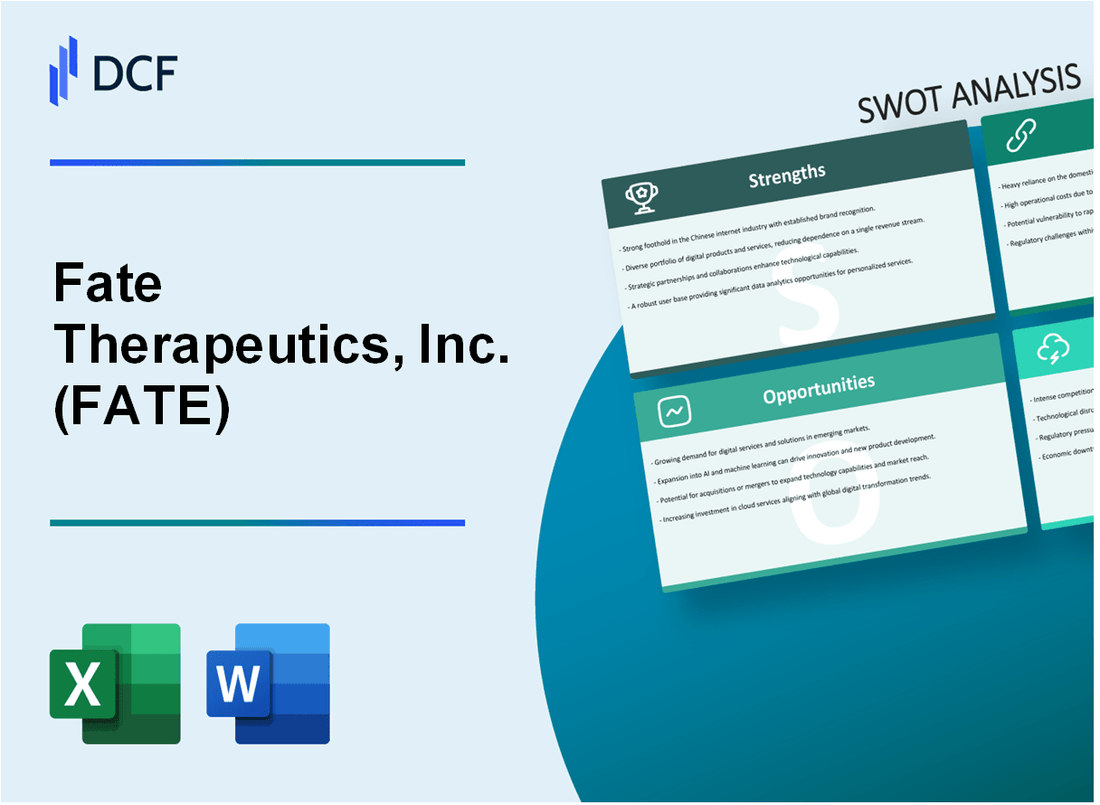
|
Fate Therapeutics, Inc. (FATE): SWOT Analysis [Jan-2025 Updated] |

Fully Editable: Tailor To Your Needs In Excel Or Sheets
Professional Design: Trusted, Industry-Standard Templates
Investor-Approved Valuation Models
MAC/PC Compatible, Fully Unlocked
No Expertise Is Needed; Easy To Follow
Fate Therapeutics, Inc. (FATE) Bundle
In the rapidly evolving landscape of cell therapy and immuno-oncology, Fate Therapeutics, Inc. (FATE) emerges as a groundbreaking innovator poised to transform cancer treatment. With its cutting-edge induced pluripotent stem cell (iPSC) technology and a robust pipeline of engineered NK and T-cell immunotherapies, the company stands at the forefront of potentially revolutionary cancer treatments. This comprehensive SWOT analysis reveals the strategic positioning, challenges, and immense potential of Fate Therapeutics as it navigates the complex world of advanced cell therapies, offering investors and healthcare professionals a critical insights into the company's competitive landscape and future prospects.
Fate Therapeutics, Inc. (FATE) - SWOT Analysis: Strengths
Pioneering Cell Therapy Platform
Fate Therapeutics has developed a unique cell therapy platform focused on engineered NK and T-cell immunotherapies. As of Q4 2023, the company has:
- 5 clinical-stage NK cell product candidates
- 3 clinical-stage T-cell product candidates
- Over 15 preclinical programs in development
Proprietary Induced Pluripotent Stem Cell (iPSC) Technology
| Technology Metrics | Quantitative Data |
|---|---|
| Total iPSC-derived cell lines | 12 unique cell lines |
| Patent portfolio | 37 issued patents |
| R&D investment in iPSC technology | $48.3 million in 2023 |
Clinical Pipeline
Fate Therapeutics maintains a robust clinical pipeline targeting multiple cancer indications:
- Hematologic malignancies: 4 active clinical trials
- Solid tumors: 3 ongoing clinical trials
- Combined clinical trial patient enrollment: 287 patients as of December 2023
Research and Development Capabilities
| R&D Metrics | 2023 Data |
|---|---|
| Total R&D expenses | $213.4 million |
| Number of active clinical trials | 7 trials |
| Research personnel | 184 scientists and researchers |
Strategic Partnerships
Collaboration network includes:
- Memorial Sloan Kettering Cancer Center
- University of California, San Diego
- Dana-Farber Cancer Institute
- Total partnership research funding: $22.6 million in 2023
Fate Therapeutics, Inc. (FATE) - SWOT Analysis: Weaknesses
Consistent Historical Net Losses and Ongoing Need for Additional Capital
Fate Therapeutics reported a net loss of $289.1 million for the fiscal year 2022. The company's accumulated deficit was $1.07 billion as of December 31, 2022.
| Financial Metric | Amount (in millions) |
|---|---|
| Net Loss (2022) | $289.1 |
| Accumulated Deficit | $1.07 |
| Cash and Cash Equivalents (Q3 2023) | $687.4 |
Limited Commercial Product Revenue
The company's revenue primarily comes from research and development activities. For the fiscal year 2022, Fate Therapeutics reported total revenue of $20.4 million, with no commercial product sales.
High Cash Burn Rate
Fate Therapeutics experienced a cash burn rate of approximately $267.3 million in 2022. The company's research and development expenses were $250.1 million for the same year.
| Expense Category | Amount (in millions) |
|---|---|
| R&D Expenses (2022) | $250.1 |
| Cash Burn Rate (2022) | $267.3 |
Relatively Small Company Size
As of December 2022, Fate Therapeutics had approximately 347 employees. The company's market capitalization was around $2.1 billion, significantly smaller compared to large pharmaceutical competitors.
Complex Cell Therapy Manufacturing Processes
The company faces significant challenges in cell therapy manufacturing, including:
- Complex genetic engineering techniques
- High production costs
- Limited scalability of current manufacturing processes
- Stringent regulatory requirements
The company's iPSC-derived cell therapy platform requires sophisticated manufacturing techniques, which pose substantial technical and economic challenges.
Fate Therapeutics, Inc. (FATE) - SWOT Analysis: Opportunities
Expanding Immunotherapy Market with Growing Demand for Innovative Cancer Treatments
The global immunotherapy market was valued at $108.3 billion in 2022 and is projected to reach $310.2 billion by 2030, with a CAGR of 13.5%. Fate Therapeutics is positioned to capitalize on this growth trajectory.
| Market Segment | 2022 Value | 2030 Projected Value | CAGR |
|---|---|---|---|
| Global Immunotherapy Market | $108.3 billion | $310.2 billion | 13.5% |
Potential for Breakthrough Treatments in Hematologic and Solid Tumor Cancers
Fate Therapeutics has multiple clinical-stage programs targeting critical cancer indications.
- NK cell therapies for hematologic malignancies
- CAR-NK and CAR-T cell platforms
- Ongoing clinical trials in multiple cancer types
Increasing Interest in Off-the-Shelf Cell Therapy Approaches
The off-the-shelf cell therapy market is expected to grow to $17.4 billion by 2027, with a CAGR of 19.2%.
| Market Segment | 2022 Value | 2027 Projected Value | CAGR |
|---|---|---|---|
| Off-the-Shelf Cell Therapy Market | $6.8 billion | $17.4 billion | 19.2% |
Possible Expansion into Additional Therapeutic Areas Beyond Oncology
Potential therapeutic expansion areas include:
- Autoimmune diseases
- Regenerative medicine
- Neurological disorders
Potential for Strategic Collaborations and Licensing Agreements
Fate Therapeutics has existing collaborations with:
- Janssen Biotech (Johnson & Johnson)
- Merck & Co.
- Memorial Sloan Kettering Cancer Center
Total collaboration and licensing revenue in 2022: $45.6 million
Fate Therapeutics, Inc. (FATE) - SWOT Analysis: Threats
Intense Competition in Cell Therapy and Immuno-Oncology Markets
The competitive landscape includes key players with significant market presence:
| Company | Market Cap | Cell Therapy Programs |
|---|---|---|
| Gilead Sciences | $73.1 billion | 8 active cell therapy programs |
| Novartis | $206.9 billion | 6 clinical-stage cell therapies |
| Kite Pharma | $16.2 billion | 5 CAR-T cell therapies |
Complex Regulatory Environment
Regulatory challenges in cell and gene therapies include:
- FDA approval rate for cell therapies: 12.4%
- Average regulatory review time: 15.2 months
- Estimated compliance cost: $19.5 million per therapy
Potential Technological Obsolescence
Emerging competitive technologies pose significant risks:
| Technology | Investment | Potential Impact |
|---|---|---|
| CRISPR Gene Editing | $3.8 billion (2023) | Potential to disrupt current cell therapy approaches |
| mRNA-based Immunotherapies | $2.5 billion (2023) | Alternative treatment modality |
Uncertain Reimbursement Landscape
Reimbursement challenges for advanced cell therapies:
- Average cost per cell therapy treatment: $475,000
- Insurance coverage rate: 62%
- Medicare reimbursement complexity: High
Potential Clinical Trial Failures
Clinical development risks include:
| Phase | Failure Rate | Average Cost of Failure |
|---|---|---|
| Phase I | 67% | $10.5 million |
| Phase II | 45% | $35.2 million |
| Phase III | 32% | $89.7 million |
Disclaimer
All information, articles, and product details provided on this website are for general informational and educational purposes only. We do not claim any ownership over, nor do we intend to infringe upon, any trademarks, copyrights, logos, brand names, or other intellectual property mentioned or depicted on this site. Such intellectual property remains the property of its respective owners, and any references here are made solely for identification or informational purposes, without implying any affiliation, endorsement, or partnership.
We make no representations or warranties, express or implied, regarding the accuracy, completeness, or suitability of any content or products presented. Nothing on this website should be construed as legal, tax, investment, financial, medical, or other professional advice. In addition, no part of this site—including articles or product references—constitutes a solicitation, recommendation, endorsement, advertisement, or offer to buy or sell any securities, franchises, or other financial instruments, particularly in jurisdictions where such activity would be unlawful.
All content is of a general nature and may not address the specific circumstances of any individual or entity. It is not a substitute for professional advice or services. Any actions you take based on the information provided here are strictly at your own risk. You accept full responsibility for any decisions or outcomes arising from your use of this website and agree to release us from any liability in connection with your use of, or reliance upon, the content or products found herein.
